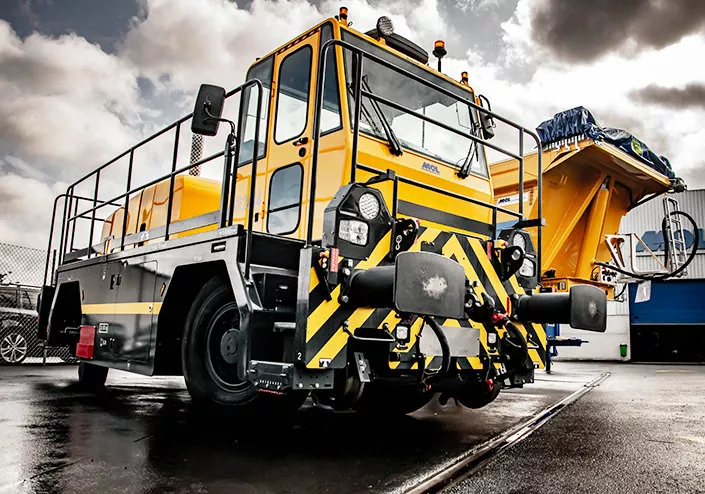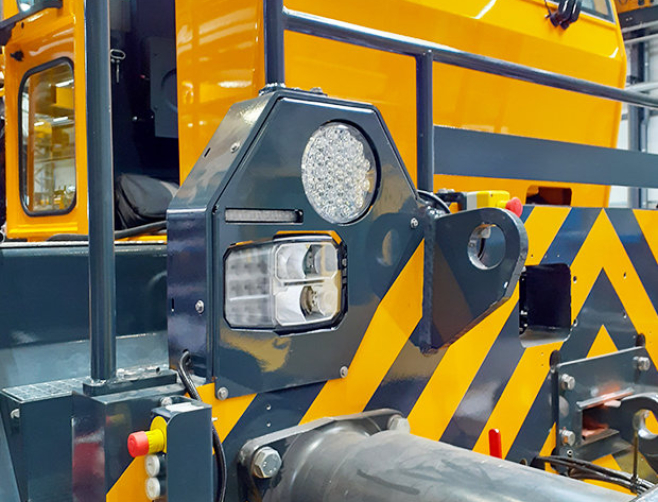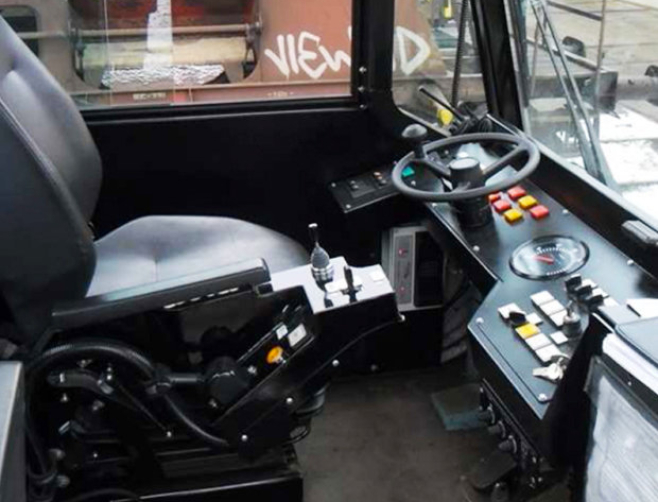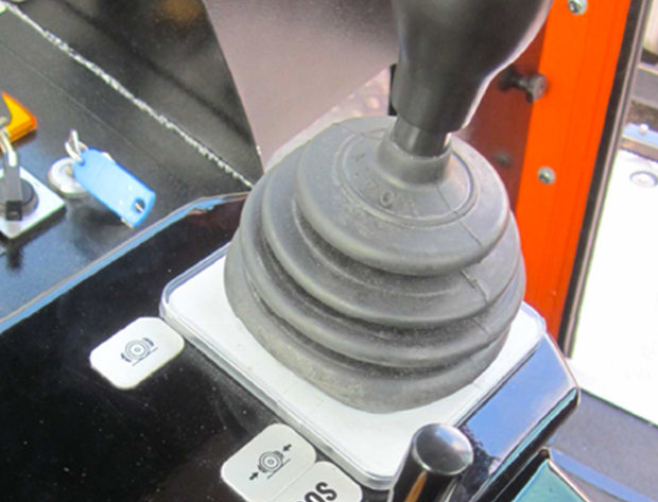The power and dependability of Mol road-rail tractor vehicles
Mol is a manufacturer of special vehicles with world wide reach. The company is more than 70 years old and designs vehicles capable of working in even the harshest environments. Great attention is paid to the choice of high quality components which is what makes Mol vehicles such outstandingly reliable working tools.
Based on its know-how, Mol has developed a range of road-rail vehicles with towing capacities ranging from 16 to 40 tonnes. Fitted with power plants ranging from 160 kW to 380 KW to the EURO5 standards, these road-rail vehicles can pull trainsets weighing anything from 1800 to 4500 tonnes.
With the capability of running on roads or rails, the road-rail vehicles are intended for use in applications demanding intensive railway carriage towing solutions. Road-rail vehicles are as suitable for driving on the road as on rails, allowing fast transfers between sites. Operating in places where goods wagons need to be moved locally at low speed (< 25 km/h) is one of the requirements facing companies with private marshalling yards, ports, cement and chemical industry, steelworks and terminals.
Versatile
Requiring 9 metres in the 4 steered wheels version and 15 metres in the 2-wheel version to get on or off the track, MOL's road-rail vehicles have guide bogies at the front and at the rear. Track changes are made by road. This ability of road-rail vehicles to get about by road reduces the costs of maintaining multiple tracks and simplifies the road-rail network on your site.
Depending on the model, road-rail vehicles can operate on tracks with rail gauges ranging from 1067 mm to 1676 mm. Note that the standard rail gauge in France is 1435 mm.
It takes less than two minutes to mount the vehicle on the track and less than 30 seconds to remove it. With its two cameras and the monitor screen in the cab, the operator can monitor accurately the position of the road-rail vehicle in relation to the tracks.
A state-of-the-art PLC assists the operator in the track-mounting and exit operations. In particular, it controls the conversion of the lighting and signalling devices when the vehicle is running alternately on the track or on the road.
Maximum grip and guidance
Rubber tyres provide traction on the rails. Road-rail vehicles develop higher driving and braking forces than a locomotive because of the friction coefficient of rubber on steel.
The road-rail vehicle is driven by means of permanent four-wheel drive. The differentials of the driving axles are locked when used on tracks. An anti-skid system ensures that the driving force is optimised when the train starts and limits tyre wear.
The vehicle is accurately steered by means of the steering axles equipped with single or double bogie rail wheels (diameter 400 mm). Each steering axle is kept under constant pressure by hydropneumatic suspension controlled by the automatic assistance system.
Large volume accumulators make for a smoothly responsive hydropneumatic suspension. The pressures on the rail guide wheels are constantly monitored and automatically adjusted if necessary.
Range
|
RR1644 |
RR2044 |
RR2444 |
RR3044 |
RR3544 |
RR4044 |
|
|---|---|---|---|---|---|---|
|
Traction capacity* |
1.800 t |
2.200 t |
2.700 t |
3.300 t |
3.900 t |
4.500 t |
|
Weight |
16 t |
20 t |
24 t |
30 t |
35 t |
40 t |
|
Traction force (µ =0,7) |
1.800 t |
2.200 t |
2.700 t |
3.300 t |
3.900 t |
4.500 t |
|
Power |
160 kW |
160 kW |
180 kW |
227 kW |
227 kW |
344 kW |
|
Power (Option) |
- |
- |
- |
- |
344 kW** |
- |
|
Railway wheels (mm) |
4x Ø400 |
4x Ø400 |
4x Ø400 |
4x Ø400 |
8x Ø400 |
8x Ø400 |
|
Coupling force |
± 85kN |
± 105kN |
± 125kN |
± 158kN |
± 185kN |
± 210kN |
|
Rail wheels (mm) (Option)** |
- |
- |
- |
8x Ø400 |
- |
- |
|
Wheel dimensions |
12.00R24 |
12.00R24 |
12.00R24 |
14.00R24 |
14.00R24 |
14.00R24 |
|
Tank |
225 l |
225 l |
450 l |
450 l |
450 l |
450 l |
|
Air production |
3,6m3/min |
3,6m3/min |
3,6m3/min |
3,6m3/min |
3,6m3/min |
3,6m3/min |
|
Air tank |
500 l |
500 l |
800 l |
800 l |
800 l |
800 l |
|
Length (incl. buffer) |
7.490 mm |
7.490 mm |
7.790 mm |
7.790 mm |
8.930 mm |
9.410 mm |
|
Length (incl. buffer)** |
- |
- |
- |
8.830 mm |
9.410 mm |
- |
|
Width |
2.530 mm |
2.530 mm |
2.530 mm |
2.530 mm |
2.530 mm |
2.530 mm |
|
Height (without accessories) |
3.700 mm |
3.700 mm |
3.700 mm |
3.700 mm |
3.700 mm |
3.700 mm |
* Under ideal conditions, dry weather, straight line, flat ground
** Options that cause a change in the initial hardware configuration
Manoeuvrability
A selector switch changes the direction of the road-rail vehicle while the vehicle is moving. There are 3 steering modes:
- 2 steering (front) wheels
- 4-wheel steering - optional
- Crab ride - optional
4 wheel steering
Crab ride
Braking systems
The road-rail vehicle are equipped with two braking systems, the vehicle brake (the direct brake) and the full rail brake (the indirect brake). The vehicle brakes are dual-circuit compressed air brakes. The emergency brake and the parking brake ensure the vehicle does not move even if there is no air pressure (failsafe).
The rail brake also controls the brakes of the road-rail vehicle when it is used on the railway tracks.
An emergency stop valve opens the general circuit in an emergency.
Both brake systems have their own compressor and air reservoir:
- One compressor is mounted on the diesel engine and generates the energy for the vehicle brakes.
- A driven screw compressor (not on RR1644 & RR2044) with a flow rate of approximately 3,600 l/min at 10 bar, and a large 800 L capacity air reservoir fill the wagons' brakes very quickly.
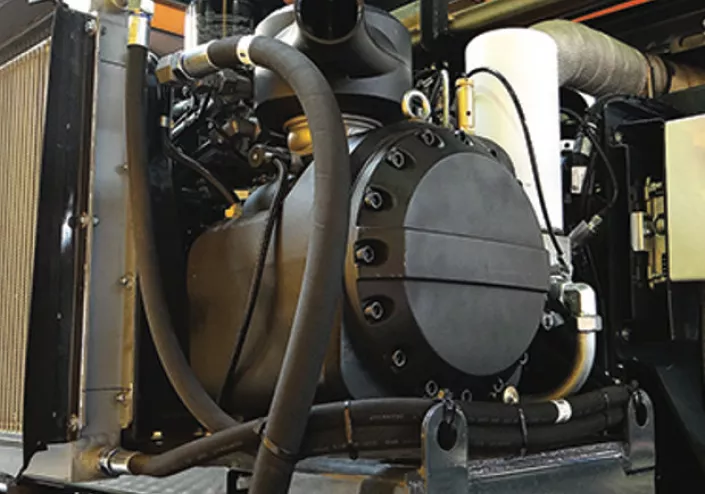
Safety
Safety was the key element in the choice of technical solutions during the development of the road-rail vehicle.
Numerous safety features prevent malfunctions, breakdowns, operating errors or carelessness, thereby protecting the equipment from damage and helping to avoid accidents:
- Steps with lighting and handles that comply with railway regulations
- Handrails all around the vehicle
- Wide and secure steps at each end of the vehicle. Passage at the front and rear of the vehicle
- Dead man's device
- Optical and acoustic signalling for road and rail operations
- Emergency stop buttons at every corner of the vehicle
- Constant monitoring and automatic correction of the pressure on the guide system
- Low centre of gravity of the vehicle
- Robust frame, high crash resistance
- Safety control of mode changes: "road mode", "rail mode" and "remote rail mode".
MOL road-rail vehicles are built according to recognised rules and comply with the EN15746 standards
Designed with experts recognised by the German Federal Railway Authority (EBA), MOL's road-rail systems comply with the railway standards of the §32 EBO certification, meeting the safety requirements of Deutsche Bahn AG.
This certification was the basis for obtaining railway certifications in Belgium, France, Germany, Switzerland, Austria, Hungary, Slovenia etc.
